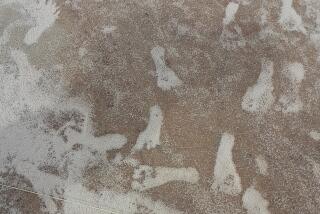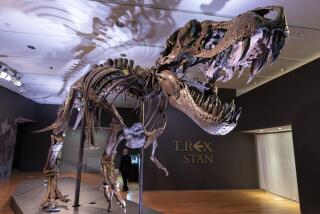What a dinosaur handprint reveals
Steven Spielberg got it wrong.
In his classic 1993 film “Jurassic Park,” the director showed Tyrannosaurus rex, Velociraptor and other carnivorous dinosaurs walking with their forearms hanging down like a monkey’s and their palms more or less parallel to the ground -- a posture derisively referred to by paleontologists as the “bunny position.”
A growing body of evidence, however, has suggested that the creatures were physically unable to assume this position because their wrist bones would not turn in such a fashion.
Now, the first unequivocal handprint of a 198-million-year-old crouching carnivore confirms the speculation, providing clear evidence that the front limb struck the ground on its side, like a karate chop, and thus would have been of little use for walking.
The extremely rare handprint from the St. George Dinosaur Discovery Site in Utah indicates that even early dinosaurs had forelimbs similar to those of birds, reinforcing the now widely held conclusion that birds are the only living descendant of the ancient monsters.
“What this seems to imply is that, even from fairly early in their history, dinosaurs were entirely bipedal and weren’t using their forearms to support themselves in any way,” said paleontologist Tom Holtz of the University of Maryland, who was not involved in the research.
“Because of that, the hands could specialize as weapons, to grab on to a struggling animal or to fight with other dinosaurs,” he said.
The handprints are among more than 1,200 dinosaur tracks deposited in mud along the shores of an ancient lake, then buried and fossilized. Most of the tracks are similar to ones found at other sites, said paleontologist Andrew Milner, lead author of the report published Tuesday:doi/10.1371/journal.pone.0004591 in the online journal PLoS One.
But one set of tracks shows the trail of a carnivore called a theropod leaving the water and climbing up a low hill on the shore.
The tracks clearly show the hind feet and, occasionally, the dragging tail. But at one point, Milner said, the theropod apparently stopped and crouched to rest.
At that point, between the footprints, is the clear circular impression of the ischium or pelvis, “basically a butt print,” Milner said.
And to each side of the tracks are the handprints, which are mirror images of each other. They clearly show the third digit pressed into the ground and traces of the second digit, with the claw curling inward.
The hands were positioned as they would be for “holding on to a basketball rather than dribbling it,” Holtz said.
The dinosaur, whose exact species is not known, sat like an ostrich or emu, Milner said. “Early on in the theropods we’re seeing bird-like behavior, and the arrangement of the bones in the arms shows a very bird-like arrangement,” he said.
Paleontologists have not been entirely certain of the hand positioning of dinosaurs because wrist bones are fragile and not generally well preserved, and much of the positioning is governed by cartilage, which is also not preserved, Holtz said.
But “unlike a skeleton, this print was made by a living, breathing dinosaur in its normal operations,” he said. “And it clearly doesn’t put its palms down, just the edges of its hands.”
--






